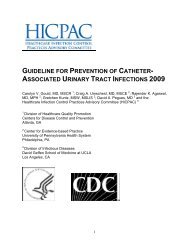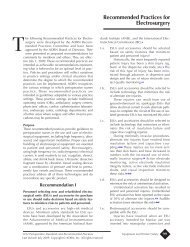Legal Issues in the Care of Pressure Ulcer Patients - Medline
Legal Issues in the Care of Pressure Ulcer Patients - Medline
Legal Issues in the Care of Pressure Ulcer Patients - Medline
You also want an ePaper? Increase the reach of your titles
YUMPU automatically turns print PDFs into web optimized ePapers that Google loves.
sttttttttttttsMost litigation occurs long after <strong>the</strong> event – sometimes years later. Thus <strong>the</strong> chart becomes <strong>the</strong>“spokesperson” for <strong>the</strong> care rendered by <strong>the</strong> entire cl<strong>in</strong>ical team and <strong>the</strong> <strong>in</strong>stitution. For that reason,cl<strong>in</strong>icians need to be m<strong>in</strong>dful <strong>of</strong> not just <strong>the</strong> chart’s present role <strong>in</strong> a patient’s care, but also <strong>in</strong> its potentialfuture role <strong>in</strong> litigation.Many cl<strong>in</strong>icians do not realize that <strong>the</strong> chart will be compared to <strong>the</strong> healthcare facility’s writtenregulations, policies, procedures and guidel<strong>in</strong>es. For example, if <strong>the</strong> facility policy requires turn<strong>in</strong>g apatient with a pressure ulcer once every four hours, failure to do that even once constitutes a breach <strong>of</strong>policy. While that may sound relatively benign to a cl<strong>in</strong>ician, <strong>the</strong> oppos<strong>in</strong>g counsel will argue that thisviolation <strong>of</strong> <strong>the</strong> facility’s own policy represents substandard care.The right tools can streaml<strong>in</strong>e documentation. Cl<strong>in</strong>icians also need to know <strong>the</strong>re is a difference betweena sk<strong>in</strong> assessment and a pressure ulcer risk assessment and that both need to be performed.S<strong>in</strong>ce documentation is a broad topic, it will be broken down <strong>in</strong>to sk<strong>in</strong> assessments, risk assessments,pressure ulcer assessments, chart<strong>in</strong>g, electronic record<strong>in</strong>g, photography and stag<strong>in</strong>g.a. Sk<strong>in</strong> AssessmentsKey Concept: Sk<strong>in</strong> assessments should be conducted regularly and <strong>in</strong> accordance with<strong>the</strong> guidel<strong>in</strong>es <strong>of</strong> a particular <strong>in</strong>stitution. Note that <strong>the</strong> sk<strong>in</strong> assessment is different from<strong>the</strong> risk assessment and both must be performed.Sk<strong>in</strong> assessments should be conducted upon admission to a facility as well as at regular<strong>in</strong>tervals, with results documented <strong>in</strong> <strong>the</strong> patient’s chart. There is no clear consensus <strong>in</strong> <strong>the</strong>cl<strong>in</strong>ical community regard<strong>in</strong>g m<strong>in</strong>imum standards for such an assessment. Based on TagF-314, <strong>the</strong>re are five key parameters that any sk<strong>in</strong> assessment performed <strong>in</strong> a long-term carefacility should address: 15• Temperature • Moisture • Color• Turgor• IntegrityWhen sk<strong>in</strong> <strong>in</strong>tegrity is compromised, <strong>the</strong> correct etiology <strong>of</strong> <strong>the</strong> alteration needs to bedocumented <strong>in</strong> <strong>the</strong> medical record by <strong>the</strong> licensed provider. Ongo<strong>in</strong>g assessment shouldbe recorded <strong>in</strong> <strong>the</strong> medical record at <strong>in</strong>tervals consistent with <strong>the</strong> care sett<strong>in</strong>g. For example,<strong>in</strong> acute care, <strong>the</strong>se sk<strong>in</strong> assessments could be daily, while <strong>in</strong> home care, sk<strong>in</strong> assessmentmight occur with every registered nurse visit.<strong>Pressure</strong> <strong>Ulcer</strong>s – With <strong>the</strong> recent change <strong>in</strong> CMS bill<strong>in</strong>g, which denies payment <strong>of</strong> <strong>the</strong>higher diagnostic category to hospital-acquired pressure ulcers, documentation <strong>of</strong> sk<strong>in</strong>assessment and pressure ulcer existence at <strong>the</strong> po<strong>in</strong>t <strong>of</strong> admission has new implications. Thisshifts even more accountability for sk<strong>in</strong> assessment to physicians. There are two ma<strong>in</strong>stttttttttttts<strong>Legal</strong> <strong>Issues</strong> <strong>in</strong> <strong>the</strong> <strong>Care</strong> <strong>of</strong> <strong>Pressure</strong> <strong>Ulcer</strong>s: Key Concepts for Healthcare Providers10
















